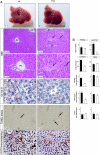Dysregulation of the peroxisome proliferator-activated receptor target genes by XPD mutations
- PMID: 15988019
- PMCID: PMC1168804
- DOI: 10.1128/MCB.25.14.6065-6076.2005
Dysregulation of the peroxisome proliferator-activated receptor target genes by XPD mutations
Abstract
Mutations in the XPD subunit of TFIIH give rise to human genetic disorders initially defined as DNA repair syndromes. Nevertheless, xeroderma pigmentosum (XP) group D (XP-D) patients develop clinical features such as hypoplasia of the adipose tissue, implying a putative transcriptional defect. Knowing that peroxisome proliferator-activated receptors (PPARs) are implicated in lipid metabolism, we investigated the expression of PPAR target genes in the adipose tissues and the livers of XPD-deficient mice and found that (i) some genes are abnormally overexpressed in a ligand-independent manner which parallels an increase in the recruitment of RNA polymerase (pol) II but not PPARs on their promoter and (ii) upon treatment with PPAR ligands, other genes are much less induced compared to the wild type, which is due to a lower recruitment of both PPARs and RNA pol II. The defect in transactivation by PPARs is likely attributable to their weaker phosphorylation by the cdk7 kinase of TFIIH. Having identified the phosphorylated residues in PPAR isotypes, we demonstrate how their transactivation defect in XPD-deficient cells can be circumvented by overexpression of either a wild-type XPD or a constitutively phosphorylated PPAR S/E. This work emphasizes that underphosphorylation of PPARs affects their transactivation and consequently the expression of PPAR target genes, thus contributing in part to the XP-D phenotype.
Figures





References
-
- Adams, M., M. J. Reginato, D. Shao, M. A. Lazar, and V. K. Chatterjee. 1997. Transcriptional activation by peroxisome proliferator-activated receptor gamma is inhibited by phosphorylation at a consensus mitogen-activated protein kinase site. J. Biol. Chem. 272:5128-5132. - PubMed
-
- Akoulitchev, S., S. Chuikov, and D. Reinberg. 2000. TFIIH is negatively regulated by cdk8-containing mediator complexes. Nature 407:102-106. - PubMed
-
- Auwerx, J. 1999. PPARγ, the ultimate thrifty gene. Diabetologia 42:1033-1049. - PubMed
-
- Berger, J., and D. E. Moller. 2002. The mechanisms of action of PPARs. Annu. Rev. Med. 53:409-435. - PubMed
-
- Bootsma, D., and J. H. J. Hoeijmakers. 1993. DNA repair. Engagement with transcription. Nature 363:114-115. - PubMed
Publication types
MeSH terms
Substances
LinkOut - more resources
Full Text Sources
Molecular Biology Databases
Research Materials
